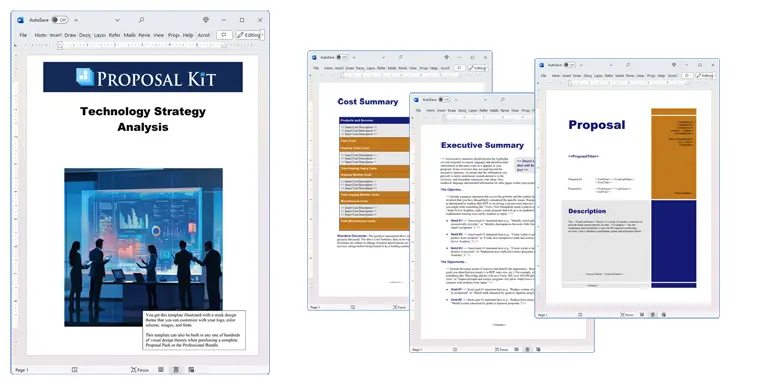How to write your Technology Strategy Analysis
We include this 19 page layout with every Proposal Pack. If you want this template to have a different visual design theme than the one illustrated here, purchase any Proposal Pack design and create this template using the purchased design theme. This template is included in every Proposal Pack. If you get a Proposal Pack or the Professional, you can also make any variation of this template with different chapters to suit your needs.
We typically include more chapters in the templates than most people will need to give everyone more variety in the chapters they may need. You can trim down a long template by removing pages you do not need or combining multiple chapter topics into one page.
 DOWNLOADABLE, ONE-TIME COST, NO SUBSCRIPTION FEES
DOWNLOADABLE, ONE-TIME COST, NO SUBSCRIPTION FEESYou can also create countless variations of this document to suit your needs using the included library of 2200+ chapters if ordering a Proposal Pack or Professional.
 What Our Clients Say
What Our Clients SayWe purchased the Proposal Pack Classic #3 today and have already nearly completed what would normally have taken us days of mental anguish to work through. You’ve got a great collection of products and I will not hesitate to recommend your company to colleagues."
Campaign Coalition
Related Article
Related Video
Related Templates
- Business Governance Plan
- Business Strategy Change and Implementation Proposal
- Sales Plan
- Organizational and Managerial Structure Report
- Company Profile Report
- Investment Strategy Proposal
- Strategic Plan
- SWOT Analysis Report
- Retail Location Business Plan
- Succession Planning Proposal
- Technology Business Plan
- Strategic Plan for Mobilization and Deployment of Project
- Business Plan
- Strategic Alliance Proposal
- Feasibility Study for Business Startup
- Security Survey, Analysis and Standard Compliance Proposal
- Acquisition Plan Proposal
- Business Plan Funding Request Proposal
- Business Management Proposal
- Business Model Change Planning Rolling Shutdowns Proposal
- Business Development Proposal
- Strategic Business Plan
- AI For Energy Management Proposal Template
- AI For Financial Fraud Detection Proposal Template
- Prescription Monitoring Software Proposal
- Replacing Legacy Computer Systems Proposal
- Server Upgrade and Maintenance Proposal
- Cloud Services Consulting Proposal
- AI Powered Educational Tools Proposal Template
- Transforming Retail Business to Service Online Proposal
- Chatbot Development Proposal Template
- Technology Consulting Proposal
- EMV Chip and Pin Migration Proposal
- Artificial Intelligence Proposal Template
- AI Based Fitness Coaching Platforms Proposal Template
- Home Assistant Artificial Intelligence Project Proposal
- Strategic Business Map
- AI Based Content Creation Proposal Template
- Geospatial Intelligence Department Setup Proposal
- AI In Manufacturing For Predictive Maintenance Proposal Template
- AI Driven Social Media Analytics Proposal Template
What's the best way to write your technology strategy analysis?
The Proposal Kit template and software package is a proven solution for writing a strategy analysis. With its extensive library of templates and robust software capabilities, Proposal Kit helps businesses conduct thorough reviews and analyses of their technology needs and future strategies. It even includes a line item quoting database system for developing detailed cost summaries, quotes, estimates, budgets, and other financial topics, ensuring a complete and professional approach to proposal writing.
Are you in a situation where you need to write an in-depth analysis of your company's technology strategy? Proposal Kit is designed for you. Tailor-made for businesses seeking to enhance their technology strategies, Proposal Kit helps you to communicate your plans clearly and.
What Types of Projects Are Technology Strategy Analysis Written For?
Technology strategy analyses are important for a variety of projects, providing insights and planning for future technology implementation and management. These are the types of situations where these are written:
- Evaluating current IT infrastructure
- Planning software upgrades
- Implementing new cybersecurity measures
- Expanding data storage capabilities
- Developing a cloud migration strategy
- Assessing technology compliance requirements
- Conducting a digital transformation project
- Designing a mobile app development plan
- Implementing Internet of Things (IoT) solutions
- Enhancing customer relationship management (CRM) systems
- Establishing a disaster recovery plan
- Initiating a blockchain integration strategy
- Formulating a big data analytics initiative
- Planning a technology training program for employees
- Exploring artificial intelligence (AI) implementation
- Improving network security protocols
- Launching a telecommuting technology program
- Setting up a virtual private network (VPN)
- Creating a business continuity strategy
- Evaluating and selecting new software vendors
Chapters this template is built with
No single premade template fits all situations. This is why Proposal Kit software enables the creation of customized documents to accommodate any situation using its extensive content library. Here are starting points for chapters that can be customized using Proposal Kit's extensive library:
Cover Letter
Set the tone for your proposal with a professional cover letter. Introduce the purpose of the strategy analysis and summarize key points that will be addressed in the document. This section should capture the reader's attention from the start and establish credibility, outlining why the analysis is important and how it aligns with the company's goals.
Introduction
Provide an overview of the strategy analysis. Explain the objectives and scope of the project, ensuring the reader understands the context and importance of the proposal. This section should articulate the reasons for conducting the analysis and set the stage for the detailed discussions that follow, ensuring that stakeholders grasp the significance of the undertaking.
Executive Summary
Highlight the important topics of the strategy analysis. Offer a concise summary of your findings and recommendations, emphasizing the overall value and benefits of implementing the proposed strategy. This section should encapsulate the main points of the proposal, allowing busy executives to quickly understand the proposal's intent and anticipated outcomes.
Needs Assessment
Analyze the current technology landscape of the company. Identify gaps and areas for improvement, presenting a strong case for why change is necessary. This chapter should detail the existing strengths and weaknesses of the company's technology infrastructure and processes, providing a foundation for the proposed strategy.
Competitive Analysis
Examine competitors' technology strategies. Compare and contrast their approaches with your company's, identifying opportunities for differentiation and competitive advantage. This involves benchmarking against industry leaders and understanding the competitive landscape to inform choices and positioning.
Industry Trends
Discuss emerging trends in technology that may impact your strategy. Demonstrate your awareness of the latest developments and how they influence your company's future plans. This section should contextualize the company's strategy within broader industry movements, ensuring the proposal is forward-looking and adaptive.
Business Drivers
Identify the primary business drivers for the technology strategy. Explain how these factors influence decision-making and guide the overall direction of your technology initiatives. Highlighting these drivers provides clarity on the motivations and helps align technological changes with business priorities.
Strategy
Detail the proposed technology strategy. Break down the steps necessary to achieve the desired outcomes, ensuring clarity and alignment with business goals. This section should provide a roadmap for implementation, specifying timelines and responsibilities to ensure the strategy's success.
Investment
Outline the financial investment required for the strategy. Provide a cost analysis and budget breakdown, highlighting the return on investment and long-term benefits. An in-depth financial overview is crucial for gaining stakeholder buy-in and ensuring that the proposal is financially viable.
Risk Analysis
Identify potential risks associated with the strategy. Discuss mitigation strategies and contingency plans to reassure stakeholders of a thoughtful approach to risk management. This chapter should address uncertainties and demonstrate a proactive stance in safeguarding the company's interests.
Technology
Explore the specific technologies involved in the strategy. Describe their roles and relevance, emphasizing how they contribute to the overall success of the project. This section should highlight the technological innovations and tools that will drive the company's objectives forward.
Next Generation
Address future technologies that may impact the strategy. Prepare for technological advancements and how they can be integrated into the company's long-term vision. This chapter should focus on staying ahead of technological shifts and maintaining a competitive edge in the industry.
Requirements
List the technical and resource requirements for implementing the strategy. Ensure all necessary components are accounted for, facilitating smooth execution. This section should cover software, hardware, personnel, and other resources needed to bring the strategy to fruition.
Recommendations
Offer actionable recommendations based on the analysis. Suggest specific actions and decisions to drive the technology strategy forward and achieve desired results. This chapter should provide a concrete plan for moving from analysis to action, helping guide decision-makers.
Summary
Summarize the key points of the proposal. Reinforce the benefits and significance of the strategy analysis, leaving a lasting impression on the reader. This concluding section should reiterate the core message and ensure that the proposal's value is clearly communicated.
Future Potential
Discuss the long-term potential and outcomes of the strategy. Highlight opportunities for growth and innovation, showcasing the forward-thinking nature of the proposal. This chapter should inspire confidence in the vision and its capacity to drive sustained success.
Use cases for this template
Cloud Solution Adoption for Retail Success
The Challenge
Tech Innovators faced an uphill battle when attempting to convince a large retail chain to transition to their new cloud solution. Mark, the lead strategist, knew that the retail industry often hesitates over significant technological shifts due to concerns about cost, implementation complexities, and potential disruptions to business operations. The retail chain's leadership expressed skepticism, fearing that the transition might entail more expenses than benefits, along with possible downtimes that could affect their bottom line.
The Solution
Understanding the need for a persuasive and data-driven proposal, Mark turned to Proposal Kit. The software's extensive library of templates allowed him to organize his proposal, addressing the retail chain's specific concerns. By using the line item quoting database, Mark created a detailed cost-benefit analysis demonstrating not only the financial efficiencies of cloud adoption but also the solution's scalability and flexibility. This comprehensive approach aimed to alleviate their financial apprehensions and highlight the long-term advantages of adopting the cloud solution.
The Implementation
Mark diligently customized the proposal using Proposal Kit's templates, focusing on chapters that were most pertinent to the retail chain's goals. The competitive analysis section provided insights into how other retail companies had successfully transitioned to cloud-based solutions, while the recommendations section outlined a step-by-step implementation plan, minimizing perceived risks. By tailoring each section to resonate with the client's business model and objectives, Mark ensured the proposal was both relevant and compelling.
The Outcome
The retail chain's decision-makers were impressed by the depth and clarity of the proposal. Mark's thorough approach and the professional presentation of the document mitigated their initial concerns about costs and implementation hurdles. As a result, Tech Innovators secured the contract, leading to a smooth cloud migration. The transition not only reduced operational costs but also enhanced the chain's efficiency and data accessibility, ultimately fostering a more innovative and responsive retail environment.
Rapid Cybersecurity Overhaul Under Tight Deadlines
The Challenge
At GreenTech Corp, Sarah, an IT manager, faced mounting pressure to propose a robust cybersecurity overhaul. With cyber threats escalating, the need for enhanced security was urgent. However, the directive came with a tight deadline and limited resources, leaving Sarah with the challenge of quickly creating a comprehensive proposal that would address all potential vulnerabilities and secure executive buy-in.
The Solution
Sarah turned to Proposal Kit to streamline the proposal writing process. The software's expansive template library allowed her to quickly pinpoint and customize the necessary chapters to fit GreenTech Corp's specific cybersecurity needs. To supplement the proposal's content, she used an AI writing tool that analyzed the company's website and internal documents, providing insights and data that enriched sections such as needs assessment and risk analysis. This approach ensured that her proposal was both data-driven and tailored to GreenTech Corp's immediate concerns.
The Implementation
The AI tool facilitated the creating of compelling narratives, emphasizing the urgency and significance of the proposed cybersecurity measures. Proposal Kit's software further enhanced the proposal by offering a professional layout and structure, ensuring that each section was logically organized and easy to navigate. By integrating these resources, Sarah was able to produce a comprehensive and polished document that communicated the necessity and benefits of the cybersecurity overhaul.
The Outcome
Sarah submitted the proposal ahead of the deadline, impressing GreenTech Corp's executive team with its thoroughness and foresight. The detailed analysis and clear recommendations led to swift approval and allocation of the necessary resources. The subsequent cybersecurity upgrade fortified the company's defenses, safeguarding sensitive data and reinforcing stakeholder confidence in GreenTech Corp's commitment to digital security.
Streamlined RFP for Non-Profit Technology Upgrade
The Challenge
John, a director at Future Possibilities, was tasked with issuing a Request for Proposal (RFP) for a new Customer Relationship Management (CRM) system. The non-profit organization needed to modernize its technological infrastructure to enhance donor engagement and streamline operations. However, with limited in-house expertise in writing RFPs and a need to attract qualified vendors, John was faced with the challenge of developing a comprehensive and clear RFP that accurately reflected the organization's requirements and expectations.
The Solution
To address this challenge, John used Proposal Kit to create a detailed and precise RFP. The software's tailored templates allowed him to outline Future Possibilities' specific requirements and objectives. By incorporating industry trends and technology requirements into the document, John ensured that the RFP was not only thorough but also aligned with the latest technological advancements. This approach helped vendors clearly understand the non-profit's needs and submit competitive proposals.
The Implementation
Proposal Kit's structured format significantly contributed to the clarity and completeness of the RFP. John was able to present the non-profit's needs in a concise and professional manner, making it easier for vendors to respond accurately. This structure also facilitated internal reviews, ensuring all stakeholders at Future Possibilities were aligned on the RFP's goals and specifications.
The Outcome
The RFP successfully attracted a pool of high-quality vendors, each offering solutions tailored to the unique needs of Future Possibilities. John and his team were able to select a partner that not only fit their budget but also offered a CRM system that significantly improved donor engagement and operational efficiency. The new system streamlined communication efforts, enhanced the organization's outreach capabilities, and ultimately supported Future Possibilities' mission in a more impactful way.
Conclusions and Recommendations
Creating a strategy analysis begins with understanding the complexity of the task at hand. Proposal Kit provides a credible, flexible solution to tackle these challenges head-on. From evaluating technology needs to formulating future strategies, its comprehensive library and software tools empower users to create detailed, professional proposals. By using Proposal Kit, businesses can communicate their visions, secure necessary resources, and propel their technology initiatives toward success.
Also Known As
This template may also be referred to in different ways or be used in more specialized situations, such as:
- Tech Strategy Assessment
- IT Strategy Review
- Digital Transformation Plan
- Future Technology Blueprint
- Technology Roadmap Analysis
- IT Needs Evaluation
- Digital Strategy Overview
- Tech Infrastructure Plan
- Technology Planning Guide
- Strategic Technology Review
Abstract
 A well-written technology strategy is important for business leaders to align technology solutions with an organization s objectives and drive business value. Developing an effective technology strategy framework involves identifying business needs, using existing technology assets, and integrating digital technology into core business processes to foster innovation and improve operational efficiency. By using practices such as swot analysis, competitive benchmarking, and analyzing current state versus future state, organizations can define goals and guide initiatives.
A well-written technology strategy is important for business leaders to align technology solutions with an organization s objectives and drive business value. Developing an effective technology strategy framework involves identifying business needs, using existing technology assets, and integrating digital technology into core business processes to foster innovation and improve operational efficiency. By using practices such as swot analysis, competitive benchmarking, and analyzing current state versus future state, organizations can define goals and guide initiatives.
Data management and the use of data centers play an important role in enabling data-driven decision-making and access to customer data, which are necessary for delivering personalized experiences and enhancing customer engagement across digital channels. The adoption of emerging technologies - including automation, machine learning, and cloud platforms - can open new revenue streams, scale productivity, and respond to customer demand and market conditions. A digital transformation strategy is supported by a detailed plan that addresses security measures, governance, vendor contracts, and the continuous learning of necessary skills. Business strategy and technology leaders must collaborate with key stakeholders to ensure alignment, which ensures maximum value and financial performance while tracking key performance indicators and gathering feedback to measure progress and optimize business performance. Using advanced strategy framework methods and consulting research allows organizations to adapt their technology environment, manage new challenges, and deliver valuable insights into customer behavior and satisfaction. For example, the Proposal Kit enables the assembly of comprehensive strategy documents, including cost analysis and detailed requirements, making it easier to define and communicate growth objectives and identify solutions in the most optimal way for an organization s specific needs.
Organizations face significant change as they strive to align their business strategy with technology investments and services that support their organization s objectives. A comprehensive technology strategy analysis enables businesses to leverage technology and data management to improve operational efficiency, reduce costs, and drive innovation. By considering the existing technology environment and understanding business requirements, organizations can access data and use valuable insights to make data-driven decisions that enhance customer engagement, refine customer interactions, and improve overall customer experience and customer satisfaction.
 A deep understanding of guiding principles and the following components - such as engineering practices, new technologies, and optimization of business processes - enables organizations to adapt and scale their products or services to meet customer demand and seize new opportunities. This approach fosters a culture of continuous improvement and collaboration among key stakeholders, ensuring that initiatives are aligned with business goals and result in successful outcomes.
A deep understanding of guiding principles and the following components - such as engineering practices, new technologies, and optimization of business processes - enables organizations to adapt and scale their products or services to meet customer demand and seize new opportunities. This approach fosters a culture of continuous improvement and collaboration among key stakeholders, ensuring that initiatives are aligned with business goals and result in successful outcomes.
With the right strategy framework, companies can expand into other areas, such as outsourcing certain IT functions or investing in new products, to remain competitive and agile. For instance, when an organization undertakes the acquisition of new technologies, a plan based on sound knowledge and principles ensures that each topic of the transition is considered for maximum effectiveness. Using document assembly tools, like Proposal Kit, streamlines the creation of tailored strategy documents, addresses different types of business needs, and reinforces a plan that is customized to the expected outcomes and specific culture of the company.
Overall, this article underscores how a technology strategy analysis, when executed, can help organizations evolve, respond to market changes, and deliver optimization in both current and future business performance. By treating technology decisions as an integral part of the overall business strategy, organizations maximize their ability to deliver new value to stakeholders and sustain growth.
 A thorough technology strategy analysis is critical for shaping business decisions that are not only aligned with the organization s objectives but also focused on sustainable growth and competitive advantage. By evaluating the many topics of the existing technology landscape, organizations can identify where to drive innovation and create value through smarter, more efficient processes. This kind of comprehensive assessment supports a proactive response to changing industry trends, allowing organizations to adapt more and seize emerging opportunities.
A thorough technology strategy analysis is critical for shaping business decisions that are not only aligned with the organization s objectives but also focused on sustainable growth and competitive advantage. By evaluating the many topics of the existing technology landscape, organizations can identify where to drive innovation and create value through smarter, more efficient processes. This kind of comprehensive assessment supports a proactive response to changing industry trends, allowing organizations to adapt more and seize emerging opportunities.
Strategic planning that centers on technology enables companies to reduce costs by optimizing resource allocation and eliminating inefficiencies. The process also ensures that investments in technology are directly tied to the organization s goals, enhancing the impact of every decision made. Each topic of the analysis, from risk assessment to solution identification, contributes to a robust foundation upon which new initiatives can be confidently launched.
Furthermore, integrating a technology strategy framework into the decision-making process gives leaders the clarity they need to prioritize projects, manage risks, and guide teams toward shared objectives. Ultimately, this approach not only promotes operational excellence but also fosters a culture where innovation thrives, and the organization remains resilient in the face of future disruption.
Frequently Asked Questions
What is the primary goal of a strategy analysis?
The primary goal of a strategy analysis is to evaluate an organization's current technology landscape and develop a plan to align technology initiatives with business objectives. This analysis helps identify gaps, opportunities, and potential risks, ensuring that technology investments contribute to the organization's long-term success. By conducting a thorough strategy analysis, companies can optimize their resources, enhance operational efficiency, and gain a competitive edge in the market.
How does a strategy analysis benefit an organization?
A strategy analysis benefits an organization by providing a structured approach to assessing technology needs and planning for future developments. It enables businesses to make informed decisions about technology investments, prioritize projects, and allocate resources. By identifying industry trends and evaluating competitive landscapes, a strategy analysis helps organizations stay ahead of technological advancements and anticipate market changes, thus maintaining their relevance and competitiveness.
What are the important components of a technology analysis?
An effective strategy analysis typically includes several key components. These include a needs assessment, which identifies the organization's current technology gaps; a competitive analysis, which evaluates the technology strategies of competitors; and an examination of industry trends, which informs planning. Additional components often include risk analysis, investment planning, and recommendations for actionable steps. These topics, when combined, form a comprehensive overview that guides the organization's technology decisions.
How often should a strategy analysis be conducted?
The frequency of conducting a strategy analysis depends on the organization's industry, size, and goals. In industries, such as technology or finance, it may be beneficial to conduct an analysis annually or even semi-annually. For other organizations, a biennial review may suffice. Regularly updating the strategy analysis ensures that the organization remains agile and responsive to changing business environments and technological advancements.
What tools can assist in writing a strategy analysis?
Several tools can assist in writing a strategy analysis, with Proposal Kit being one of the options. Proposal Kit offers a comprehensive library of customizable templates tailored for strategy analysis. It helps streamline the writing process, ensuring that all critical components are included and presented professionally. Additionally, Proposal Kit's line item quoting database facilitates accurate financial analysis, making it a valuable resource for creating detailed and convincing proposals.
20% Off Discount
![]() Add To Cart This Word Template
Add To Cart This Word Template
 Add To Cart Proposal Pack for Any Business
Add To Cart Proposal Pack for Any Business
 Add To Cart Proposal Kit Professional
Add To Cart Proposal Kit Professional
 4.7 stars, based on 849 reviews
4.7 stars, based on 849 reviewsProposal Kit chapters used in this template
Cover Letter, Title Page, Table of Contents, Introduction, Executive Summary, Needs Assessment, Industry Trends, Business Drivers, Competitive Analysis, Risk Analysis, Technology, Next Generation, Strategy, Investment, Future Potential, Requirements, Recommendations, Summary, Back Page
You use this proposal for
- General business proposal
- Technical proposal
- Project pitch proposal
- Internal company proposal
- Business document, study, plan, report
- IT, software, hardware proposal
How to create this template with Proposal Pack Wizard
You can create this document using any of the logo-designed Proposal Packs. Pick any Proposal Pack with a logo design theme you like best; they will all work equally well. The Proposal Pack for Any Business is the pack with no extra added logos or colors - designed to be used plain or for you to customize with your logos and graphics.
The Proposal Pack design theme you purchase will determine the visual look of this template. The screenshot above only shows the plain generic design theme.
We include a library of chapters to be assembled based on your needs. All proposals are different and have different needs and goals. We designed Proposal Pack so you can customize the documents to suit your needs.
You will best create this document using the Proposal Pack Wizard - Expert Edition software to select this template and build it in the Proposal Pack logo design theme of your choice along with any desired customizations (such as adding additional chapters, removing unneeded chapters, changing the order of chapters, and importing your company logo). This template outlines a proposal for the described situation. Each user is responsible for typing in the actual content of the provided pages with their information to complete the proposal. Suggestions in the abstract may include features in higher-end packages and are facilitated by the selection of chapter templates to support the narrative of each proposal, which help guide the user in filling in the details.
The Wizard software's AI Writer will write the content of the pages of the template based on details provided for your company, client, project, financial details and other writing instructions. This will provide a personalized version of the template completely written and ready to edit.
Once finished, the AI Writer's Word-to-PowerPoint converter can transform your proposal, business plan, or other business documents into a PowerPoint slideshow. Save time and effort by letting the AI analyze every chapter to condense its content into talking points, visually matching the document, and providing a consistent package of presentation material with the click of a button.
You create this template using the Wizard software with an entire Proposal Pack library and software. We include the Expert Edition of the software in the Proposal Kit Professional. Microsoft Word for Windows is required to use the customizing software. You can also edit Word document templates in other office software such as Word for Mac. We will assist Mac users in assembling complex templates for their first project if they do not have the required platform to run the Wizard software.
How to Build Templates Featured on Proposal Kit Website
Many people find the Proposal Kit website after searching for a specific proposal. Once you've purchased and installed the software, how do you build that template you found in the first place? This video shows you how to build any proposal you see on the Proposal Kit website.
 Ian Lauder has been helping businesses write their proposals and contracts for two decades. Ian is the owner and founder of Proposal Kit, one of the original sources of business proposal and contract software products started in 1997.
Ian Lauder has been helping businesses write their proposals and contracts for two decades. Ian is the owner and founder of Proposal Kit, one of the original sources of business proposal and contract software products started in 1997.By Ian Lauder
 Published by Proposal Kit, Inc.
Published by Proposal Kit, Inc.


 Cart
Cart
 Get 20% off ordering today:
Get 20% off ordering today: 


 Facebook
Facebook YouTube
YouTube Bluesky
Bluesky Search Site
Search Site